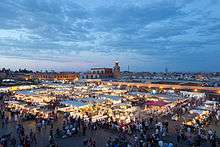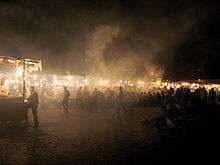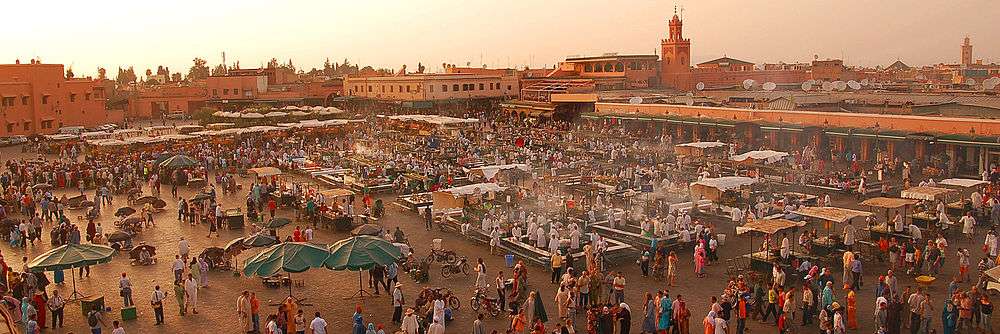Jemaa el-Fnaa

Jamaa el Fna (Arabic: ساحة جامع الفناء saaHat jamaaʻ al-fanâʼ, also Jemaa el-Fnaa, Djema el-Fna or Djemaa el-Fnaa) is a square and market place in Marrakesh's medina quarter (old city). It remains the main square of Marrakesh, used by locals and tourists.
Name
The origin of its name is unclear: Jemaa means "congregation" in Arabic, probably referring to a destroyed Almoravid mosque. Fanâʼ or finâʼ can mean "death" or "a courtyard, space in front of a building". "finâʼ in arabic commonly means "open area", straight translation would be "the gathering/congregation area". Other meanings could be "The assembly of death," or "The Mosque at the End of the World".[1] Another explanation is that it refers to a mosque with a distinctive courtyard or square in front of it.[2] A third translation is "assembly of the dead", referring to public executions on the plaza around 1050 AD.[3]
History
Marrakesh was founded by the Almoravids 1070-1072. After a destructive struggle, it was falling to the Almohads in 1147. Following this, Jamaa el-Fna was renovated along with much of the city. The city walls were also extended by Abou Yacoub Youssef and particularly by Yacoub el Mansour from 1147-1158. The surrounding mosque, palace, hospital, parade ground and gardens around the edges of the marketplace were also overhauled, and the kasbah was fortified. Subsequently, with the fortunes of the city, Jamaa el Fna saw periods of decline and also renewal.[4]
The Square
During the day it is predominantly occupied by orange juice stalls, water sellers with traditional leather water-bags and brass cups, youths with chained Barbary apes and snake charmers despite the protected status of these species under Moroccan law.[5][6]
As the day progresses, the entertainment on offer changes: the snake charmers depart, and late in the day the square becomes more crowded, with Chleuh dancing-boys (it would be against custom for girls to provide such entertainment), story-tellers (telling their tales in Berber or Arabic, to an audience of locals), magicians, and peddlers of traditional medicines. As darkness falls, the square fills with dozens of food-stalls as the number of people on the square peaks.

The square is edged along one side by the Marrakesh souk, a traditional North African market catering both for the common daily needs of the locals, and for the tourist trade. On other sides are hotels and gardens and cafe terraces, and narrow streets lead into the alleys of the medina quarter.
Once a bus station, the place was closed to vehicle traffic in the early 2000s. The authorities are well aware of its importance to the tourist trade, and a strong but discreet police presence ensures the safety of visitors.
UNESCO Masterpiece of the Oral and Intangible Heritage of Humanity
The idea of the UNESCO project Masterpieces of the Oral and Intangible Heritage of Humanity came from people concerned about the Jamaa el Fna. The place is known for its active concentration of traditional activities by storytellers, musicians and performers, but it was threatened by economic development pressures. In fighting for the protection of traditions, the residents called for action on an international level, to recognize the need for the protection of such places — termed "cultural spaces" — and other popular and traditional forms of cultural expression.[7]
UNESCO encourages communities to identify, document, protect, promote and revitalize such heritage. The UNESCO label aims to raise awareness about the importance of oral and intangible heritage as an essential component of cultural diversity.
| “ | The spectacle of Jamaa el Fna is repeated daily and each day it is different. Everything changes — voices, sounds, gestures, the public which sees, listens, smells, tastes, touches. The oral tradition is framed by one much vaster — that we can call intangible. The Square, as a physical space, shelters a rich oral and intangible tradition. | ” |
| — Juan Goytisolo, in a speech delivered at the opening meeting for the First Proclamation, 15 May 2001[8] | ||
2011 bombing

Shortly before noon on April 28, 2011, a blast originating in a cafe in the square killed 17 people and injured another 25. Initial reports blamed an accidental gas explosion, but officials later blamed "criminals" and "terrorists".[9]
Trivia
- Jemaa El-Fnaa, Marrakech's main square was featured in the 25th Season of The Amazing Race, Episode 5.
- The square was featured in the Alfred Hitchcock movie The Man Who Knew Too Much (1956).
- An interesting account of the place in the 1970s can be seen in Esther Freud's novel Hideous Kinky.
- Jimmy Page and Robert Plant recorded some songs and their DVD "No Quarter - Unledded" here.
- Juan Goytisolo lived in Marrakesh and had had an important role in the categorization of Jamaa el Fna as one of the Masterpieces of the Oral and Intangible Heritage of Humanity
- The square was featured as a photo shoot setting in the TV reality series America's Next Top Model Cycle 16.
- Some reports have it that political activists are sometimes imprisoned and abused in the police jail under Jamaa el Fna.[10]
References
- ↑ The Mosque at the End of the World, Tahir Shah, BBC Radio 3, 10 April 2010
- ↑ ""Jam'a al-Fnaa Square: a large square surrounded by mysteries" (Arabic)". Newspaper. Mararakech Press. Archived from the original on 23 March 2012. Retrieved 28 April 2011.
- ↑ "Djemaa El-Fna". Lonely Planet.
- ↑ "Medina of Marrakesh - UNESCO World Heritage Centre". Whc.unesco.org. 2008-11-11. Retrieved 2014-07-15.
- ↑ "Life, Adventures and Discoveries: Mysteries of Marrakech Morocco". Lifeadventurestariq.blogspot.com. 2010-04-28. Retrieved 2014-07-15.
- ↑ Bergin and Nijman (2014) Open, Unregulated Trade in Wildlife in Morocco’s Markets. TRAFFIC Bulletin Available from researchgate.net, accessed Mar 23, 2015.
- ↑ "Convention for the Safeguarding of the Intangible Cultural Heritage 2003". UNESCO. Retrieved 2009-09-05.
- ↑ Juan Goytisolo (2001-05-15). "Defending Threatened Cultures". Unesco.org. Retrieved 2009-09-07.
- ↑ "Morocco: Marrakesh bomb strikes Djemaa el-Fna square". BBC News. 28 April 2011.
- ↑ "Ilham's Story: Torture to the beat of Jamaa al Fna drums". Kasama Project. 29 July 2011. Archived from the original on January 5, 2015.
- The Rough Guide To Morocco, 2001. Rough Guide Publishing ISBN 1-85828-601-8
External links
| Wikimedia Commons has media related to Jamaa El Fna. |
| Wikivoyage has a travel guide for Marrakech#Medina. |
- The Time Machine | Photography portfolio about Jamaa El-Fna
- Official Website | Official Website about Jamaa El-Fna
- BBC news about preserving intangible patrimony
- A Night at Jamaa El-Fna - article in English with many high-quality pictures
Coordinates: 31°37′33″N 7°59′22″W / 31.62583°N 7.98944°W
